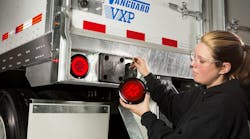The Commercial Vehicle Safety Alliance (CVSA) International Roadcheck is coming soon; it will take place this year between May 4 and May 6 in the U.S., Canada, and Mexico. CVSA chose lighting as the mechanical fitness category of emphasis for 2021, which means that all required lighting devices are to be inspected for proper color, operation, mounting, and visibility. The condition and location of reflectors and retroreflective sheeting and conspicuity tape are also to be inspected.
In a time when telematics, artificial intelligence, and machine learning hold the promise of so much in the way of predictive maintenance, when it comes to lighting and electrical issues we have to deal with the realities of today. While there may be some new technologies out there that can help, they are not widespread, nor are they going to help the vast majority of fleets avoid violations this year.
There is not yet an algorithm capable of tracking down or correcting electrical and lighting issues, and until there is, technicians will have to continue to troubleshoot and correct electrical and lighting problems the old-fashioned way – through the process of elimination. It is still a matter of power and ground.
Working our way back
If a maintenance department already has a well-documented preventive maintenance (PM) protocol in place, they are well prepared. They likely already periodically examine the entire electrical and lighting system on each vehicle. The fleet will benefit from this diligence and professionalism during this year’s Roadcheck event.
For a fleet that is not as prepared, it is important to take note of the following to get through May 4-6.
Start by examining the out of service (OOS) lighting violations in the U.S. from the 2020 International Roadcheck event. There were 821 in the U.S., which is virtually half of the 1,650 overall violations, including Canada and Mexico.If this year is anything like last year, about 726, or 88.4 percent of OOS violations can be avoided by making sure that a vehicle has all of its lights working for those three days. Close to half of this year’s OOS violations can probably be avoided by checking to make sure that the turn signals are operating properly.
Considering how important lighting is to the safety of a fleet’s drivers, its capital investments, and the public at large, it should not seem like a big ask, and because it can literally be seen whether the lights are on or off, lighting operation is one of the easiest items to check on any vehicle.
A fleet’s drivers are the last line of defense against infractions during International Roadcheck and all other times of the year, so it is important to remind drivers that they are required by law to inspect their truck and trailer before starting their shift and again every 24 hours on the road. They need to be encouraged to do just that, starting now and leading up to the May event, and to never stop doing it.
Make drivers part of the maintenance team
Before a driver starts a pre-trip inspection, they might be asking themselves a few questions.
- Did my fleet take the required maintenance and service steps to support proper lighting operation on my vehicle?
- Did my fleet make educated decisions in selecting or specifying electrical and lighting technology?
- Did fleet management adequately train me to perform a driver vehicle inspection?
Drivers who know the answers to these questions are indicative of a well-run fleet, and well-trained drivers and maintenance crews work together. Without knowledge, understanding, cooperation, teamwork, and training, even a good maintenance program can be undermined by an uninformed, untrained driver in the field.
Training and monitoring are key. Every driver needs to know how to perform a pre-trip inspection and what to look for. They must also know that someone will be monitoring them periodically on best practices.
Most drivers have likely been taught to do some version of an inspection, and though any inspection is better than none, it is better to know that they have the knowledge to do it the way the fleet wants it done. The best way to encourage this behavior is to require a vehicle checklist-based inspection report and to let the drivers know that it will be monitored.
People who are considered experts in their fields, such as airline pilots and surgeons, use checklists every day – not because they are forgetful, but because they ensure repetitive and sometimes mundane details will not get missed.
While there are not any legal guidelines governing how long a pre-trip inspection should take, a proper inspection will take somewhere between 30 and 50 minutes. Doing an inspection properly requires following a process, focus, and vigilance as the driver moves methodically around each area of the vehicle.
Some critical lighting features that can easily get overlooked are reflectors and conspicuity tape. These passive safeguards are there as a critical precaution and a key feature of safety and visibility. They can also save lives in situations where lighting and power have been lost on a vehicle.
During International Roadcheck and any other time, for that matter, drivers can receive violations for having defective reflectors and conspicuity tape. Working together, maintenance crews and drivers need to make sure that reflectors are free of cracks and dirt. Be aware that over time, conspicuity tape can also deteriorate so that it is no longer sufficiently reflective, thus making it a candidate for an infraction or, worse yet, a collision.
Over the long haul
Once a fleet has gotten through International Roadcheck 2021, they need to focus on every other day of the year. Since lighting infractions are so conspicuous, it is important to tighten things up right away.
Optronics encourages every fleet to establish and adhere to a well-documented PM schedule, including the thorough examination of a vehicle’s entire electrical and lighting system beginning on day one.
If OEMs have positioned wiring and connectors in high-moisture areas, such as just above or behind tires, the fleet maintenance team may want to add ancillary protective coverings in the form of boots, plastic looms, moldings, or tubing.
These measures not only help reduce high-pressure moisture exposure, they also diminish the potential damage that can be inflicted by rocks, road debris, and ice accumulation that can place undue stress on wiring and connection points.
During the new vehicle inspection, maintenance professionals should make sure that all lighting is correctly installed and operational. They should look for wires and cables that are bent sharply and those that come into contact with metal edges, such as where wires pass through walls or into body cavities.
Dielectric grease can be added to grounding ring terminals that are improperly connected to a frame member and might otherwise produce a galvanic response caused by two dissimilar metals making contact.
To the extent possible, corrections should be made and the system augmented as needed. Any wiring that appears to be loosely hanging should be secured. If unused connectors are spotted, these should immediately be capped.
Once the vehicle is in service, maintenance personnel should focus on seals, connection points, and cable and wiring integrity.
Fleets should follow this five-point approach:
- Start corrosion prevention on the day the fleet takes possession of the vehicle.
- Train drivers to perform proper pre-trip inspections (make them a part of the maintenance protocol).
- Train everyone on the team on how to spot corrosion and where to look for it.
- Stick to a regimented PM schedule.
- Replace incandescent lamps with LED lamps.
The cable and wiring augmentation described above will help guard against corrosion, but if problems arise, here is what to look for. Wiring and harness problems usually come in three identifiable categories:
- Failure due to a grounded circuit
- Failure due to an open circuit
- Failure due to a short circuit
The matter of training
We find that there is a fundamental lack of systematic processes and procedures training for fleet maintenance technicians, so in 2016, Optronics launched its Bright Ideas Technical Training Program. The program is designed to help today’s fleets become more competent and knowledgeable about lighting and electrical issues.
The Bright Ideas Technical Training Program is a comprehensive instructional system that provides a fundamental understanding of electricity, vehicle wiring, lighting connections, installation, and basic troubleshooting – all within the context of federal regulations and CSA requirements.
Optronics will conduct the free training sessions at a fleet or distributor location, and participants who finish the free course receive a certificate of course completion and a free Bright Ideas tool kit.
With Optronics’ Bright Ideas Technical Training Program, fleets can reduce exposure to violations by addressing electrical and lighting issues and by gaining a deeper understanding of both lighting operations and regulations.
By taking some practical steps in the short term and some intelligent steps in the long term, a fleet can get through International Roadcheck 2021 and be prepared for whatever their trucks meet on the road ahead.
Optronics International | USA Harness International is a leading manufacturer of vehicle harnesses, electronic control systems, and LED lighting for the global transportation industry. Kyle O'Dell is the company’s director of engineering and new product development. O’Dell has over 22 years of experience designing and manufacturing consumer products. He has an extensive background in marine electronic systems, aircraft harnessing, and automotive and commercial vehicle lighting.





